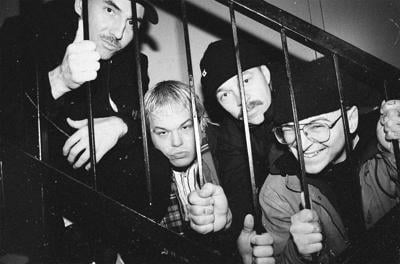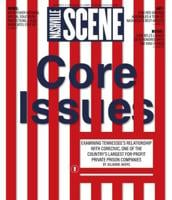
Béton Armé
It’s never been easy for artists who sing in languages other than English to get noticed in the United States. So I asked Oli Sasseville why his Canadian band sings in French. He plays bass in Montreal, Quebec’s Béton Armé (whose name translates to “reinforced concrete”), who will be stopping by Nashville on Saturday for their second visit this year. They’re one of three Francophone punk troupes — along with eerie Lyon/Paris trio Bleakness in April and Paris’ brilliantly saccharine power poppers Alvilda in July — to play Nashville so far in 2025.
“It’s our first language,” says Sasseville. “And also the bands that inspired us were, for the most part, the French ones from the ’80s who all sang in French. I think it’s between five and six years, over the past 20 maybe, that I’ve spent in France.”
Béton Armé’s album Renaissance, released in August,is one of the catchiest punk records of 2025. “Guitar is always with the rhythm section, and the bass and the vocals are the melody, so we try also to use a ton of gang vocals and ‘whoas,’” Sasseville says. A fan recently noted that the LP has a “whoa” count of 545, averaging out to 23.7 WPMs (Whoas Per Minute). “So it creates its own melody on top of the guitar.”
During his time in France, Sasseville became integrated into Paris’ well-known oi! community. For those unaware, oi! is a subsect of punk that emerged from the British pubs in the late ’70s as the other side of the coin from the scene born in art schools. Oi! was the sound of disaffected working-class youth who were too busy trying to make ends meet to go around sticking safety pins through their septums.
The sound reverberated across the English Channel: In 1983 and 1984, the two volumes of the compilation albums Chaos en France showcased the sounds of the streets across l’hexagone, introducing the world to Komintern Sect and Camera Silens. Oi! spread to Italy, where leading bands were anti-fascist group Klasse Kriminale and Nabat, who dedicated their 1986 LP Un Altro Giorno Di Gloria to South African activists Benjamin Moloise and Nelson Mandela.
These French and Italian scenes served as inspiration for Béton Armé’s style more than the U.K. or U.S. bands. “If you look at [French and Italian] bands and you draw your influences from them, I think it’s a much better sound, and it’s a lot more interesting,” says Sasseville.
Despite the European flavor, Béton Armé’s home is still Montreal. The cover of their 2018 self-titled demo tape features a drawing of their hometown landmark: the Farine Five Roses marquee, a well-known flour mill sign that has illuminated the city skyline since 1948.
“When you cross the bridge to get into the city, it’s right in your face,” Sasseville explains. “That’s kind of a wink to the working-class history of Montreal, but as well as a landmark that everyone from that city recognizes.”
The working class, a common theme in the oi! realm, is important to Béton Armé. When asked about his band’s day jobs, Sasseville gives an unexpected answer. “One electrician and two others work in renovation,” he says. “I have a Ph.D. in history, so it’s a different path that I took.”
Sasseville got his doctorate in France, where he studied the rise of far-right political movements. He researched the neofascist movement Ordre Nouveau, which merged with the French National Front, which today exists as a political party called National Rally.
“And it’s within that movement that the National Front was created in the early ’70s,” he explains. “So I was studying this sort of transition from a more openly fascist, very, very fringe movement to a sort of political party that could present candidates at every election and then be kind of within the mainstream political arena.”
How mainstream, you ask? While you might not be familiar with NF founder Jean-Marie Le Pen, a long-running political figure known for Nazi sympathies and hateful statements about immigrants, you might be aware of his daughter, Marine Le Pen, a National Rally candidate who got 41.5 percent of the vote in France’s 2022 presidential election. Growing up on the left side, Sasseville saw importance in studying how the other side worked, especially after seeing the rise of the far right in Western Europe.
“I just thought it’s important to document and understand how and why they’re able to achieve what they’re achieving right now, which hasn’t been seen since the Second World War.”





